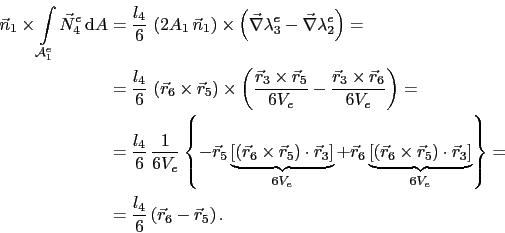![$\displaystyle \int_{\mathcal{A}_{N1}}\vec{n}\cdot\left[ \vec{N}_i\times\left( \...
...{1}{\gamma}\vec{\nabla}\times\vec{N}_j \right) \right] \mathrm{d}A = [D]\{c\}.$](img828.gif) |
(C.1) |
The Neumann boundary integral (5.29) becomes
![$\displaystyle \int_{\mathcal{A}_{N1}}\vec{n}\cdot\left[ \vec{N}_i\times\left( \...
...{1}{\gamma}\vec{\nabla}\times\vec{N}_j \right) \right] \mathrm{d}A = [D]\{c\}.$](img828.gif) |
(C.1) |
The assembly of the matrix ![]() with entries
with entries
![$\displaystyle D_{ij} = \int_{\mathcal{A}_{N1}}\vec{n}\cdot\left[ \vec{N}_i\times\left( \frac{1}{\gamma}\vec{\nabla}\times\vec{N}_j \right) \right] \mathrm{d}A$](img830.gif) |
(C.2) |
is performed element by element, whereby only
the elements lying on the Neumann boundary are
considered. The elements are tetrahedra and in each element ![]() is represented by the vector edge functions (5.45) to
(5.50).
is represented by the vector edge functions (5.45) to
(5.50).
The integral domain transformation for an arbitrary surface in the three-dimensional space is the same as in Appendix A and is derived in a similar manner. The integral is represented as a sum
 |
(C.3) |
The surface
![]() is subdivided into pieces
is subdivided into pieces
![]() with areas
with areas ![]() .
. ![]() is
point inside
is
point inside
![]() . The transformation is given by
. The transformation is given by
| (C.4) |
An area ![]() is calculated as
is calculated as
![\begin{displaymath}\begin{split}A_i & = \left\vert [\vec{r}(\xi+h,\eta) - \vec{r...
...\times\vec{r}_{\eta}(\xi,\eta)\right]hk\right\vert, \end{split}\end{displaymath}](img833.gif) |
(C.5) |
which leads again to (A.8) and (A.7).
Now the element matrix ![]() can be computed. As there are four outer triangular
faces on each tetrahedral element, there will be four different element matrices for
each face which lies on the Neumann boundary
can be computed. As there are four outer triangular
faces on each tetrahedral element, there will be four different element matrices for
each face which lies on the Neumann boundary
![\begin{displaymath}\begin{split}D_{ij}^e & = \int_{\mathcal{A}^e_k}\vec{n}_k\cdo...
...ma}\vec{\nabla}\times\vec{N}^e_j\right), k\in[1;4] \end{split}\end{displaymath}](img835.gif) |
(C.6) |
and using (5.52)
![$\displaystyle D_{ij}^e = \frac{1}{3\gamma V_e}\left(\vec{n}_k\times\int_{\math...
...ec{N}^e_i \mathrm{d}A\right)\cdot\left(l_j \vec{r}_{7-j}\right), k\in[1;4].$](img836.gif) |
(C.7) |
![]() is the face opposite to the node
is the face opposite to the node ![]() .
. ![]() is
a constant vector with the characteristic length 1, perpendicular to
is
a constant vector with the characteristic length 1, perpendicular to
![]() and points outwards.
and points outwards. ![]() is assumed to be constant
in each element. Only the three
is assumed to be constant
in each element. Only the three
![]() functions
for the edges in the
functions
for the edges in the
![]() plane are not perpendicular to
plane are not perpendicular to
![]() . The remaining three vector functions are perpendicular to
. The remaining three vector functions are perpendicular to ![]() .
Consequently these vectors are parallel to
.
Consequently these vectors are parallel to ![]() and the
corresponding vector product
and the
corresponding vector product
![]() becomes zero.
becomes zero.
For the element face
![]() the element matrix is given as follows
the element matrix is given as follows
| (C.8) |
![$\displaystyle D_{4j}^e = \frac{1}{3\gamma V_e}\left(\vec{n}_1\times\int_{\math...
...ec{N}^e_4 \mathrm{d}A\right)\cdot\left(l_j \vec{r}_{7-j}\right), k\in[1;4].$](img843.gif) |
(C.9) |
The integral is computed using the integral domain transformation discussed above.
 |
(C.10) |
 |
(C.11) |
Thus the final solution for the fourth edge (![]() ) is given by the expression
) is given by the expression
 |
(C.12) |
The same procedure is used for remaining edges (with index ![]() ):
):
 |
(C.13) |
 |
(C.14) |
Analogously it is proceeded for the remaining faces.
For the face
![]() :
:
| (C.15) |
 |
(C.16) |
 |
(C.17) |
 |
(C.18) |
For the face
![]() :
:
| (C.19) |
 |
(C.20) |
 |
(C.21) |
 |
(C.22) |
For the face
![]() :
:
| (C.23) |
 |
(C.24) |
 |
(C.25) |
 |
(C.26) |